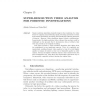Free Online Productivity Tools
i2Speak
i2Symbol
i2OCR
iTex2Img
iWeb2Print
iWeb2Shot
i2Type
iPdf2Split
iPdf2Merge
i2Bopomofo
i2Arabic
i2Style
i2Image
i2PDF
iLatex2Rtf
Sci2ools
100
click to vote
IFIP
2007
Springer
2007
Springer
Super-Resolution Video Analysis for Forensic Investigations
Super-resolution algorithms typically improve the resolution of a video frame by mapping and performing signal processing operations on data from frames immediately preceding and immediately following the frame of interest. However, these algorithms ignore forensic considerations. In particular, the high-resolution video evidence they produce could be challenged on the grounds that it incorporates data or artifacts that were not present in the original recording. This paper presents a super-resolution algorithm that differs from its counterparts in two important respects. First, it is explicitly parameterized, enabling forensic video analysts to tune it to yield higher quality in regions of interest at the cost of degraded quality in other regions. Second, the higher resolution output is only constructed in the final visualization step. This allows the intermediate refinement step to be repeatedly composed without tainting the original data.
Communications | Forensic Video Analysts | IFIP 2007 | Signal Processing Operations | Super-resolution Algorithm |
| Added | 08 Jun 2010 |
| Updated | 08 Jun 2010 |
| Type | Conference |
| Year | 2007 |
| Where | IFIP |
| Authors | Ashish Gehani, John H. Reif |
Comments (0)

